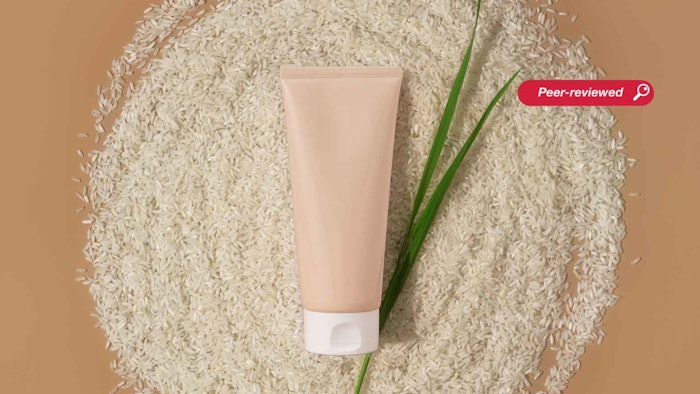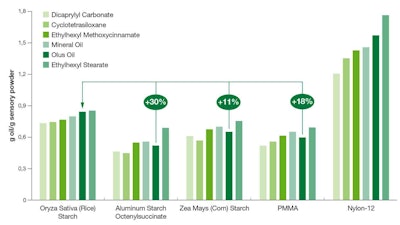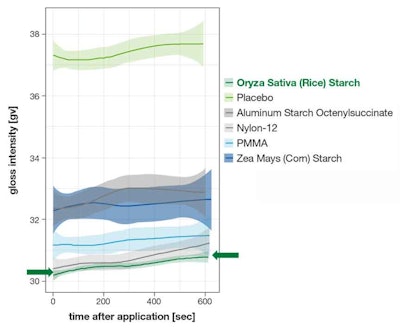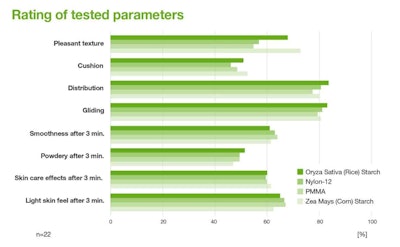
Sustainability is emerging as an important focus for both cosmetic consumers and regulators. Consumers seek personal care products that are sourced and manufactured responsibly, and that do not negatively impact the environment at any stage in the value chain.1 At the same time, governments and industry bodies are introducing new laws for safety and environmental protection. This includes the European Commission’s Chemicals Strategy for Sustainability2 and the European Green Deal.3 In the U.S. market, polymers are affected by the ban on rinse-off cosmetics containing plastic microbeads under the Microbead-Free Waters Act 2015.4
See related: Can Natural Polymers Replace Synthetic Carbomers?
The shift in consumer expectations and tighter regulations create challenges for cosmetic manufacturers. For one, there is a clear need to develop formulas whose synthetic polymers are replaced by ingredients that are responsibly sourced, bio-based and biodegradable. Sensory modifiers, in particular, such as polymethyl methacrylate (PMMA) and nylon-12, are of growing concern due to their non-biodegradable properties. However, a switch to sustainable ingredients for cosmetic products must be achieved while retaining performance and sensory properties that are equivalent to or better than those provided by traditional ingredients. This is important because sensory characteristics are a key criterion for consumers when selecting cosmetic products.5
As such, a novel rice-derived sensory modifier (INCI: Oryza Sativa (Rice) Starch) was developed as a sustainable alternative to traditional sensory ingredients. The rice starch powder has a small particle size distribution to provide a light and smooth skin feel, and it is produced from broken, non-GMO upcycled rice6 sourced within the European Union.7 It is IECIC listed for use in China, 100% natural in accordance with ISO 16128, suitable for use in vegan formulations, and COSMOS and Natrue approved.
Here, the rice starch sensory modifier is tested for oil absorption properties, matte effects and sensory performance as well as skin tolerance. Its results are compared with those of benchmarks.
See related: 'Pressed' for Powders: Replacing Dimethicone with Plant-derived Alternatives
Experimental Design
Oil absorption: To determine the oil absorption capabilities of the rice starch, measurements were made using six oils and compared with the efficacy of four benchmarks: PMMA, nylon-12, aluminum starch octenylsuccinate and Zea mays (corn) starch. Oil absorption is linked to specific area and particle porosity. The higher the specific area and porosity, the higher the oil absorption. Here, the oil absorption capacity was evaluated using gravimetric analysis.
Mattifying effect: The mattifying effect of the rice starch was evaluated using experiments based on a simplified model of light interaction with the skin. A round LED panel with a linear polarization filter that emitted warm white light was mounted 40 cm above the measurement area. A digital camera was fixed on a tripod 15 cm above the measurement area and a 90-degree switchable linear polarization filter was mounted in front of the lens. This setup allows for taking cross and parallel polarized images. The image data was then subtracted from one another to obtain images containing only gloss. These were evaluated using image analysis software to extract the gloss intensity parameter.
Sensory performance: To evaluate the sensory performance of the rice starch during and after use, test formulations were sampled blindly and randomly by a trained panel of 11 volunteers in a pair-wise comparison. A defined parameter set of 25 attributes of the formulations was assessed by panelists using their fingers on their forearms during and after product absorption.
Grading was conducted on a five-point scale, from minus one to plus one; i.e., compared with the reference – meaning the test product’s properties could be more- or less-highly pronounced, more- or less-slightly pronounced, or the same. After determining the degree of the parameters, the volunteers gave their associations in a creative statement.
The sensory assessment took place in an air-conditioned room at a temperature of 22°C and a relative humidity of 40%. No application of any leave-on products was made to the forearms for 24 hr prior to the test. A measured amount (150 µL) of the product was applied to the inside of each forearm and distributed there in 20 big circles.
Yes/no sensory rating: Additionally, sensory assessments of the rice starch sensory modifier were performed in a yes/no rating test of three benchmarks: PMMA, nylon-12 and Zea mays (corn) starch. Twenty-two panelists were recruited to evaluate whether specified attributes were present or not: a pleasant texture, cushion distribution, glide, smoothness after 3 min, powdery feel after 3 min, skin care effect after 3 min and light skin feel after 3 min. They applied test formulations to their volar forearms in an air-conditioned room at 22°C and 40% relative humidity. No application of any leave-on products was made to the forearms for 24 hr prior to the test. The tests were conducted in a double-blind mode.
Skin tolerance: Human Repeated Insult Patch Tests (hRIPT) are generally used to confirm that a material poses no risk for skin irritation or sensitization at its usage level. This test is based on the principles described by Marzulli and Maibach (1979).8 Following approval by an ethics committee, a dermatologist-controlled assessment of skin reactions (irritation and sensitization) to the test sample was carried out via visual evaluation after repeated applications. For this purpose, the skin reactions of 101 participants representing the general population and with different skin types (Fitzpatrick phototypes II, III), genders and ages (from 18 to 67 years) were evaluated.
The rice starch ingredient was used at 55% (dry weight) in glycerin; 20 µL was applied to the backs of volunteers using small Finn chambers (8 mm). Applications took place three times per week for a three-week period and reactions were monitored during this time. After a two-week recovery phase, the substance was re-applied on the same skin area. Skin reactions were assessed after a 48-hr period of contact and 15 to 30 min after patch removal.
Results: Oil Absorption and Matte Effects
Rice starch achieved higher levels of oil absorption with all six test oils than the non-porous or low-porous sensory powders PMMA, Zea mays (corn) starch and aluminum starch octenylsuccinate. As shown in Figure 1, the rice starch demonstrated a 30% higher ability to absorb olus oil than aluminum starch octenylsuccinate. Its efficacy was also 11% higher than the Zea mays (corn) starch and 18% higher than PMMA. Note that olus oil was chosen because it has a similar composition (e.g., some fatty acids) to sebum (e.g., oleic acid) and is used in some synthetic sebum types.9
 Figure 1. Oil absorption test comparing rice starch with four market benchmarks
Figure 1. Oil absorption test comparing rice starch with four market benchmarks
Tests with additional oil samples provided similar observations. Compared with aluminum starch octenylsuccinate, Zea mays (corn) starch and PMMA, the rice starch biopolymer showed a higher oil absorption ability. Notably, the synthetic nylon-12 showed even higher oil absorption, which is due to its highly porous structure.
In terms of mattifying effects, the formulation containing 3% rice starch provided the best results, although its performance was comparable to the same formulations replacing the rice starch with 3% PMMA or 3% nylon-12 (see Figure 2).
 Figure 2. Mattifying effect of rice starch compared with sensory modifier benchmarks
Figure 2. Mattifying effect of rice starch compared with sensory modifier benchmarks
Results: Sensory Performance/Ratings and Safety
For the pairwise comparison sensory assessment, note that only significant differences are shown. The results indicated the rice starch contributed to desirable sensory expectations. Formulations with the rice starch imparted comparable skin feel to the synthetic sensory modifiers PMMA and nylon-12. Furthermore, compared with the placebo, the rice starch provided significantly better results in glide performance, absorption after 1 min and smoothness after 3 min (not shown).
The rating tests for sensory properties also showed the formula containing the rice starch delivered a skin feel that was comparable to synthetic alternatives. It made a particularly strong contribution to “pleasant texture,” “distribution,” “gliding” and “powdery feel,” compared with the benchmark ingredients (see Figure 3).
 Figure 3. Sensory performance tests comparing rice starch with synthetic sensory modifiers
Figure 3. Sensory performance tests comparing rice starch with synthetic sensory modifiers
*Results are shown as the percentage of the 22 assessors who assigned the respective property to the products
Lastly, the hRIPT demonstrated the rice starch posed no risk of sensitization and it provided good skin compatibility under the test conditions. This indicated it can be used in numerous application types, especially where skin compatibility is key.
Discussion
The tests described here confirm the novel rice starch sensory modifier could be implemented to respond to the growing consumer demand for eco-friendly yet high-performing solutions. The ingredient’s ability to absorb oil suggests potential sebum-absorbing effects on skin (based on close homolog C16-18 triglycerides). Furthermore, mattifying tests demonstrated its suitability for matte-type cosmetics.
In addition, the rice starch demonstrated desirable sensory attributes such as a pleasant texture, cushion, distribution, glide and a powdery skin feel – all of which positively influence consumers’ buying decisions. The ingredient is therefore proposed to meet the demand for sustainable products that do not compromise on quality or sensory performance.
Conclusion
The rice starch sensory modifier described here was shown to match or even exceed the performance of synthetic polymers. It enables cosmetic manufacturers to move away from synthetic polymers, stay a step ahead of increasingly strict regulations, and tap into the growing consumer preference for sustainable cosmetic products.
Indeed, surveys have shown that consumers are increasingly seeking cleaner label products. For example, according to an internal Mintel report, in the U.S. market, 25% of consumers ages 25 to 34 report they are worried about the environmental impact of their personal care products. As a result, solutions such as the presented rice starch sensory modifier hold attractive potential for cosmetic producers to meet customer expectations and lead the way forward in this dynamic global market.
References
1. Morgante, F. (2022). Certified sustainable palm oil and clean beauty – The role palm oil derivates play in meeting consumers’ expectations. HP&C Today 17(3) 24-26.
2. European Commission. (Accessed 2022, Dec 29). Chemicals strategy for sustainability. Available at https://ec.europa.eu/info/strategy/priorities-2019-2024/european-green-deal_en#timeline
3. European Commission. (Accessed 2022, Dec 29). A European Green Deal – Striving to be the first climate-neutral continent. Available at: https://ec.europa.eu/info/strategy/priorities-2019-2024/european-green-deal_en
4. U.S. Food and Drug Administration (Accessed 2022, Dec 29). The Microbead-Free Waters Act: FAQs. Available at: https://www.fda.gov/cosmetics/cosmetics-laws-regulations/microbead-free-waters-act-faqs
5. In-Cosmetics connect. (2018, Sep 3). The importance of sensorial analysis in product development. Available at: https://bit.ly/3i0u0Oc
6. Lionetti, N. and Montoli, M. (2022). How upcycling advances zero waste beauty. Cosm & Toil 137(7) 44-49.
7. European Commission. (Accessed 2022, Dec 29). Rice – Market data on production, price and trade for different rice types and stages of the production chain (paddy, husked, semi-milled and milled). Available at https://bit.ly/3YYZp4c
8. Marzulli, F.N. and Maibach, H.I. (1976). Contact allergy predictive testing in man. Contact Dermatitis (2) 1-17.
9. Scientific Services S/D Inc. (Accessed 2022, Dec 29). A9 synthetic sebum. Available at https://sciservsd.com/a-9-synthetic-sebum-datasheet.html










